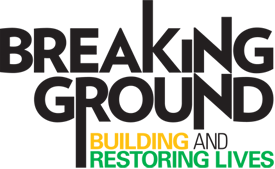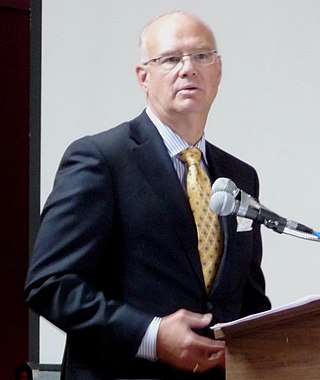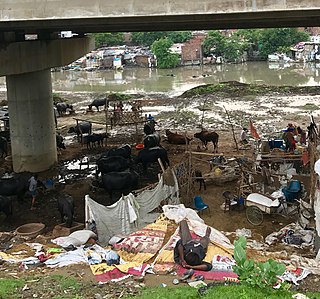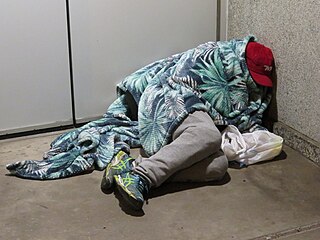Related Research Articles

Homelessness in Canada was not a social problem until the 1980s. The Canadian government housing policies and programs in place throughout the 1970s were based on a concept of shelter as a basic need or requirement for survival and of the obligation of government and society to provide adequate housing for everyone. Public policies shifted away from rehousing in the 1980s in wealthy Western countries like Canada, which led to a de-housing of households that had previously been housed. By 1987, when the United Nations established the International Year of Shelter for the Homeless (IYSH), homelessness had become a serious social problem in Canada. The report of the major 1987 IYSH conference held in Ottawa said that housing was not a high priority for government, and this was a significant contributor to the homelessness problem. While there was a demand for adequate and affordable housing for low income Canadian families, government funding was not available. In the 1980s a "wider segment of the population" began to experience homelessness for the first time – evident through their use of emergency shelters and soup kitchens. Shelters began to experience overcrowding, and demand for services for the homeless was constantly increasing. A series of cuts were made to national housing programs by the federal government through the mid-1980s and in the 1990s. While Canada's economy was robust, the cuts continued and in some cases accelerated in the 1990s, including cuts to the 1973 national affordable housing program. The government solution for homelessness was to create more homeless shelters and to increase emergency services. In the larger metropolitan areas like Toronto the use of homeless shelters increased by 75% from 1988 to 1998. Urban centres such as Montreal, Laval, Vancouver, Edmonton, and Calgary all experienced increasing homelessness.

In the United States, the number of homeless people on a given night in January 2022 was 582,462 according to the Department of Housing and Urban Development. Annual federal HUD reports contradict private state and local reports where homelessness is shown to have increased each year since 2014 across several major American cities, with 40 percent increases noted in 2017 and in 2019.

Affordable housing is housing which is deemed affordable to those with a household income at or below the median as rated by the national government or a local government by a recognized housing affordability index. Most of the literature on affordable housing refers to mortgages and a number of forms that exist along a continuum – from emergency homeless shelters, to transitional housing, to non-market rental, to formal and informal rental, indigenous housing, and ending with affordable home ownership.
Housing First is a policy that offers unconditional, permanent housing as quickly as possible to homeless people, and other supportive services afterward. It was first discussed in the 1990s, and in the following decades became government policy in certain locations within the Western world. There is a substantial base of evidence showing that Housing First is both an effective solution to homelessness and a form of cost savings, as it also reduces the use of public services like hospitals, jails, and emergency shelters. Cities like Helsinki and Vienna in Europe have seen dramatic reductions in homelessness due to the adaptation of Housing First policies, as have the North American cities Columbus, Ohio, Salt Lake City, Utah, and Medicine Hat, Alberta.

Poverty in the United Kingdom is the condition experienced by the portion of the population of the United Kingdom that lacks adequate financial resources for a certain standard of living, as defined under the various measures of poverty.

Breaking Ground, formerly Common Ground, is a nonprofit social services organization in New York City whose goal is to create high-quality permanent and transitional housing for the homeless. Its philosophy holds that supportive housing costs substantially less than homeless shelters — and many times less than jail cells or hospital rooms, and that people with psychiatric and other problems can better manage them once they are permanently housed and provided with services. Since its founding in 1990 by Rosanne Haggerty, the organization has created more than 5,000 units of housing for the homeless. "This is about creating a small town, rather than just a building," according to Haggerty. "It's about a real mixed society, working with many different people." Haggerty left the organization in 2011 to found Community Solutions, Inc. Brenda Rosen was promoted from Director, Housing Operations and Programs to Executive Director, and has led the organization since.

Homelessness or houselessness – also known as a state of being unhoused or unsheltered – is the condition of lacking stable, safe, and functional housing. The general category includes disparate situations, including:

Dean Fortin served as mayor of Victoria, British Columbia, from 2008 to 2014.

Homelessness is a major issue in India. The Universal Declaration of Human Rights defines 'homeless' as those who do not live in a regular residence. The United Nations Economic and Social Council Statement has a broader definition for homelessness; it defines homelessness as follows: ‘When we are talking about housing, we are not just talking about four walls and a roof. The right to adequate housing is about security of tenure, affordability, access to services and cultural adequacy. It is about protection from forced eviction and displacement, fighting homelessness, poverty and exclusion. India defines 'homeless' as those who do not live in Census houses, but rather stay on pavements, roadsides, railway platforms, staircases, temples, streets, in pipes, or other open spaces. There are 1.77 million homeless people in India, or 0.15% of the country's total population, according to the 2011 census consisting of single men, women, mothers, the elderly, and the disabled. However, it is argued that the numbers are far greater than accounted by the point in time method. For example, while the Census of 2011 counted 46,724 homeless individuals in Delhi, the Indo-Global Social Service Society counted them to be 88,410, and another organization called the Delhi Development Authority counted them to be 150,000. Furthermore, there is a high proportion of mentally ill and street children in the homeless population. There are 18 million street children in India, the largest number of any country in the world, with 11 million being urban. Finally, more than three million men and women are homeless in India's capital city of New Delhi; the same population in Canada would make up approximately 30 electoral districts. A family of four members has an average of five homeless generations in India.

Homelessness is a social crisis that has been rapidly accelerating in the Canadian city of Vancouver, British Columbia, over the last decade. According to the United Nations, homelessness can either be relative or absolute. Absolute homelessness describes people living in absence of proper physical shelter. Relative homelessness describes people living in poor conditions of health or security, including an absence of both personal safety and steady income despite having physical shelter to reside in. As of 2011, roughly 2,651 people in Vancouver are subject to one of these types of homelessness, or are transitioning between them. Homelessness as a social issue in Vancouver originated from federal funding cuts to affordable housing. After market housing increased, the cost of housing became one of Vancouver's main causes of homelessness, alongside lack of income. The homeless population in Vancouver is subjected to high amounts of crime-related victimization. There have been several approaches to reducing the homeless population in Greater Vancouver by the city and other organizations. As of 2011, the rate of homelessness in Vancouver has stopped increasing, but it is not being reduced either. British Columbia, as the only province without a deadly winter season, sees many migrate from other provinces.

The San Francisco Bay Area comprises nine northern California counties and contains four of the ten most expensive counties in the United States. Strong economic growth has created hundreds of thousands of new jobs, but coupled with severe restrictions on building new housing units, it has resulted in an extreme housing shortage which has driven rents to extremely high levels. The Sacramento Bee notes that large cities like San Francisco and Los Angeles both attribute their recent increases in homeless people to the housing shortage, with the result that homelessness in California overall has increased by 15% from 2015 to 2017. In September 2019, the Council of Economic Advisers released a report in which they stated that deregulation of the housing markets would reduce homelessness in some of the most constrained markets by estimates of 54% in San Francisco, 40 percent in Los Angeles, and 38 percent in San Diego, because rents would fall by 55 percent, 41 percent, and 39 percent respectively. In San Francisco, a minimum wage worker would have to work approximately 4.7 full-time jobs to be able to spend less than 30% of their income on renting a two-bedroom apartment.

Family homelessness refers to a family unit who do not have access to long term accommodation due to various circumstances such as socioeconomic status, access to resources and relationship breakdowns. In some Western countries, such as the United States, family homelessness is a new form of poverty, and a fast growing group of the homelessness population. Some American researchers argue that family homelessness is the inevitable result of imbalanced “low-income housing ratio” where there are more low-income households than there are low-cost housing units. A study in 2018 projected a total of 56,342 family households were recognized as homeless. Roughly 16,390 of these people were living in a place not meant for human habitation. It is believed that homeless families make up about a third of the United States’ population, with generally women being the lead of the household.
The number of people living in dangerous and subpar housing has significantly expanded as a result of the economic and financial crisis. The issue at hand no longer solely affects one nation in the world. The majority of nations are attempting to solve this issue in some form. Because of increased unemployment and declining wages, more people are unable to afford housing costs, increasing their risk of being homeless. Spain, which suffered greatly from COVID-19 and the accompanying economic downturn, is likewise grappling with a huge rural population decline problem. Homelessness is a serious socioeconomic issue that affects 40,000 people in Spain. Immigrants make up a disproportionate number of the homeless population. There are a lot of young people who are homeless; according to some estimates, 30% of Spain's homeless are between the ages of 18 and 29. Just 5% of the country's population, according to Spain's Research Institute for Depopulation and Development of Rural Areas, resides there. Homelessness and public begging are not officially forbidden under Spanish law.

Homelessness is a growing problem in Colorado and is considered the most important social determinants of health. Homelessness is very difficult for many Coloradoans to escape due to the continuous increase in costs for housing in Colorado, along with mental health treatments and other factors. When people are forced to live without stable shelter, they are then exposed to a number of risk factors that affect physical and mental health. Although it is difficult to pin point any one cause of homelessness, there is a complicated combination of societal and individual causes.

The United States Department of Housing and Urban Development estimated that more than 181,399 people were experiencing homelessness in California in January 2023. This represents more than 27% of the homeless population of the United States even though California has slightly less than 12% of the country's total population, and is one of the highest per capita rates in the nation, with 0.46% of residents being homeless. More than two-thirds of homeless people in California are unsheltered, which is the highest percentage of any state in the United States. 49% of the unsheltered homeless people in the United States live in California: about 123,423 people, which is eight times as many as the state with the second highest total. Even those who are sheltered are so insecurely, with 90% of homeless adults in California reporting that they spent at least one night unsheltered in the past six months.

Since about 1970, California has been experiencing an extended and increasing housing shortage, such that by 2018, California ranked 49th among the states of the U.S. in terms of housing units per resident. This shortage has been estimated to be 3-4 million housing units as of 2017. Experts say that California needs to double its current rate of housing production to keep up with expected population growth and prevent prices from further increasing, and needs to quadruple the current rate of housing production over the next seven years in order for prices and rents to decline.

Housing insecurity is the lack of security in an individual shelter that is the result of high housing costs relative to income, poor housing quality, unstable neighborhoods, overcrowding, and, but may not include, homelessness.

For many decades, the New York metropolitan area has suffered from an increasing shortage of housing, as housing supply has not met housing demand. As a result, New York City has the highest rents of any city in the United States.

Columbus, the capital city of Ohio, has a history of social services to provide for low- and no-income residents. The city has many neighborhoods below the poverty line, and has experienced a rise in homelessness in recent decades. Social services include cash- and housing-related assistance, case management, treatment for mental health and substance abuse, and legal and budget/credit assistance.

The majority of Americans (64%) own their own homes, a rate that is less than the home ownership rates other large countries such as China (90%), Russia (89%), Mexico (80%), or Brazil (73%).
References
- ↑ "Federal and State Resources for Students Experiencing Homelessness". learning policy institute.
- ↑ Rix, Kate. "How Schools Serve Homeless Students". usnews.
- 1 2 3 4 "Homeless US student population 'highest in more than a decade'". BCC.
- 1 2 3 4 "This college student was among the 'invisible' homeless. Now, a creative housing fix is helping her stay in school". CNN.
- ↑ "Number of Homeless Students Soars". usnews.
- 1 2 "California university students struggle with housing insecurity". aljazeera.